Combustion Process Emissions Control of Reciprocating Engines
2.5.2 Emissions Control
Options
Emissions from natural
gas SI engines have improved significantly in the last decade through better design
and control of the combustion process and through the use of exhaust catalysts.
Advanced lean burn natural gas engines are available that produce NOx levels as
low 1.8 lb/MWh and CO emissions of 8.1lb/MWh before any exhaust gas treatment.
Adding selective catalytic reduction (SCR) and a CO oxidation catalyst can
allow lean burn reciprocating engines to meet the very stringent California
South Coast emissions standards of 0.07 lb/MWh for NOx and 1.0 lb/MWh for CO.
NOx control has been the
primary focus of emission control research and development in natural gas engines.
The following provides a description of the most prominent emission control
approaches.
2.5.2.1
Combustion Process Emissions Control
Control of combustion
temperature has been the principal focus of combustion process control in gas engines.
Combustion control requires tradeoffs – high temperatures favor complete burn
up of the fuel and low residual hydrocarbons and CO, but promote NOx formation.
Lean combustion dilutes the combustion process and reduces combustion
temperatures and NOx formation, and allows a higher compression ratio or peak
firing pressures resulting in higher efficiency. However, if the mixture is too
lean, misfiring and incomplete combustion occur, increasing CO and VOC
emissions.
Lean burn engine
technology was developed during the 1980s as a direct response to the need for cleaner
burning gas engines. As discussed earlier, thermal NOx formation is a function
of both flame temperature and residence time. The focus of lean burn
developments was to lower combustion temperature in the cylinder using lean
fuel/air mixtures. Lean combustion decreases the fuel/air ratio in the zones
where NOx is produced so that peak flame temperature is less than the
stoichiometric adiabatic flame temperature, therefore suppressing thermal NOx
formation. Most lean burn engines use turbocharging to supply excess air to the
engine and produce the homogeneous lean fuel-air mixtures.
Lean burn engines
generally use 50 to 100 percent excess air (above stoichiometric). The typical uncontrolled
emissions rate for lean burn natural gas engines is between 1.5-6.0 lb/MWh.
As discussed above, an
added performance advantage of lean burn operation is higher output and higher
efficiency. Optimized lean burn operation requires sophisticated engine
controls to ensure that combustion remains stable and NOx reduction is
maximized while minimizing emissions of CO and VOCs.
Table 2-9 shows data for
a large lean burn natural gas engine that illustrates the tradeoffs between NOx
emissions control and efficiency. At the lowest achievable NOx levels (45 to 50
ppmv), almost 1.5 percentage points are lost on full rated efficiencyCombustion
temperature can also be controlled to some extent in reciprocating engines by
one or more of the following techniques:
• Delaying combustion by
retarding ignition or fuel injection.
• Diluting the fuel-air
mixture with exhaust gas recirculation (EGR), which replaces some of the air and
contains water vapor that has a relatively high heat capacity and absorbs some
of the heat of combustion.
• Introducing liquid
water by direct injection or via fuel oil emulsification – evaporation of the water
cools the fuel-air mixture charge.
• Reducing the inlet air
temperature with a heat exchanger after the turbocharger or via inlet air humidification.
• Modifying valve
timing, compression ratio, turbocharging, and the combustion chamber configuration.
Water injection and EGR
reduce diesel NOx emissions 30 to 60 percent from uncontrolled levels. The incorporation
of water injection and other techniques to lean burn gas engines is the focus
of ongoing R&D efforts for several engine manufacturers and is being pursued
as part of the Department of
Energy’s Advanced
Reciprocating Engine Systems (ARES) program. One of the goals of the program is
to develop a 45 percent efficient (HHV) medium sized natural gas engine
operating at 0.3 lb NOx/MWh (0.1 g NOx/bhph).
2.5.2.2
Post-Combustion Emissions Control
There are several types
of catalytic exhaust gas treatment processes that are applicable to various
types of reciprocating engines. Table 2-10 shows the methods in use today, the
applicable engine types, and the pollutant reduction achievable.
2.5.2.3
Oxidation Catalysts
Oxidation catalysts
generally are precious metal compounds that promote oxidation of CO and hydrocarbons
to CO2 and H2O in the presence of excess O2. CO and non-methane hydrocarbon
analyzer (NMHC) conversion levels of 95 percent are achievable. Methane
conversion may approach 60 to 70 percent. Oxidation catalysts are now widely
used with all types of engines, including diesel engines. They are being used
increasingly with lean burn gas engines to reduce their relatively high CO and hydrocarbon
emissions.
2.5.2.4
Diesel Particulate Filter
While not an issue for
spark ignition engines firing gaseous fuels, compression ignition engines
fueled by diesel or heavy oil produce particulates that must be controlled.
Diesel particulate filters can reduce over 90 percent of particulate (soot)
emissions from diesel engines. There are a variety of filter materials and
regeneration strategies used. Currently, there are no commercially available
particulate control devices available for large, medium speed diesel engines.31
2.5.2.5
Three–Way Catalyst (Non Specific Catalytic Reduction)
The catalytic three-way
conversion process (TWC) is the basic automotive catalytic converter process that
reduces concentrations of all three major criteria pollutants – NOx, CO, and
VOCs. The TWC is also called non-selective catalytic reduction (NSCR). NOx and
CO reductions are generally greater than 90 percent, and VOCs are reduced
approximately 80 percent in a properly controlled TWC system. Because the
conversions of NOx to N2, the conversion of CO and hydrocarbons to CO2 and H2O
will not take place in an atmosphere with excess oxygen (exhaust gas must
contain less than 0.5 percent O2), TWCs are only effective with stoichiometric
or rich-burning engines. Typical “engine out” NOx emission rates for a rich burn
engine are 10 to 15 gm/bhp-hr. NOx emissions with TWC control are as low as
0.15 g/bhp-hr.
Stoichiometric and rich
burn engines have significantly lower efficiency than lean burn engines (higher
carbon emissions) and only certain sizes (<1.5 MW) and high speeds are
available. The TWC system also increases maintenance costs by as much as 25
percent. TWCs are based on noble metal catalysts that are vulnerable to
poisoning and masking, limiting their use to engines operated with clean fuels
(e.g., natural gas and unleaded gasoline). In addition, the engines must use
lubricants that do not generate catalyst poisoning compounds and have low
concentrations of heavy and base metal additives.
Unburned fuel, unburned
lube oil, and particulate matter can also foul the catalyst. TWC technology is not
applicable to lean burn gas engines or diesels.
2.5.2.6
Selective Catalytic Reduction (SCR)
This technology
selectively reduces NOx to N2 in the presence of a reducing agent. NOx
reductions of 80 to 90 percent are achievable with SCR. Higher reductions are
possible with the use of more catalyst or more reducing agent, or both. The two
agents used commercially are ammonia (NH3 in anhydrous liquid form or aqueous
solution) and aqueous urea. Urea decomposes in the hot exhaust gas and SCR
reactor, releasing ammonia. Approximately 0.9 to 1.0 mole of ammonia is
required per mole of NOx at the SCR reactor inlet in order to achieve an 80 to
90 percent NOx reduction.
SCR systems are
considered commercial today and represent the only technology that will reduce
NOx emissions to the levels required in Southern California and the Northeast
U.S. Still, SCR adds significantly to the capital and operating cost of a
reciprocating engine CHP system. As shown previously in Table 2-4, SCR with
oxidation catalyst and associated continuous energy monitoring system adds between
$150-$700/kW to the capital cost for a lean burn reciprocating engine CHP
installation. The cost burden is higher for smaller engines.
2.5.3
Gas Engine Emissions Treatment Comparison
Table 2-11 shows
achievable emissions for each of the five representative gas engine systems.
The emissions presented assume available exhaust treatment. System 1, the 100
kW engine, is a high speed, rich burn engine. Use of a TWC system with EGR
provides NOx emissions of just under 0.07 lb NOx per MWh after credit is taken
for the thermal energy provided.32 The Lean burn engine systems use an SCR/CO
system providing emissions reduction that meets the CARB 2007 emissions limits
without consideration of the thermal energy credit.
With current commercial
technology, highest efficiency and lowest NOx are not achieved simultaneously.
Therefore many manufacturers of lean burn gas engines offer different versions
of an engine – a low NOx version and a high efficiency version – based on
different tuning of the engine controls
and ignition timing. With the addition of SCR after-treatment, described below,
some manufacturers tune engines for higher efficiency and allow the SCR system
to remove the additional NOx. Achieving highest efficiency operation results in
conditions that generally produce twice the NOx as low NOx versions (e.g., 3
lb/MWh versus 1.5 lb/MWh). Achieving the lowest NOx typically entails sacrifice
of 1 to 2 points in efficiency (e.g., 38 percent versus 36 percent). In
addition, CO and VOC emissions are higher in engines optimized for minimum NOx.
If you are interested in diesel generator, please feel free to contact us to obtain price.

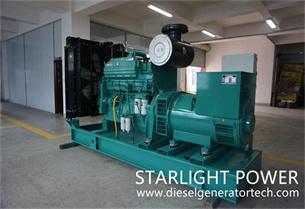
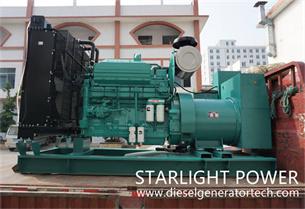
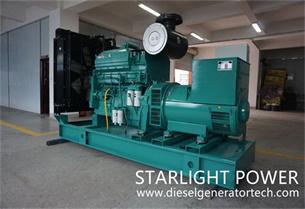
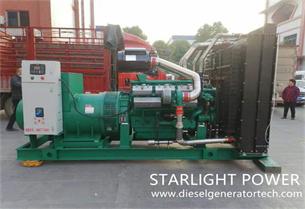


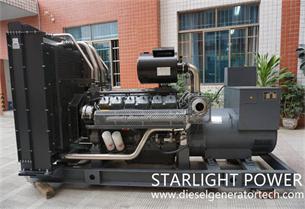
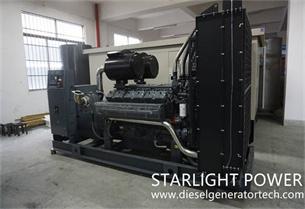

Comments